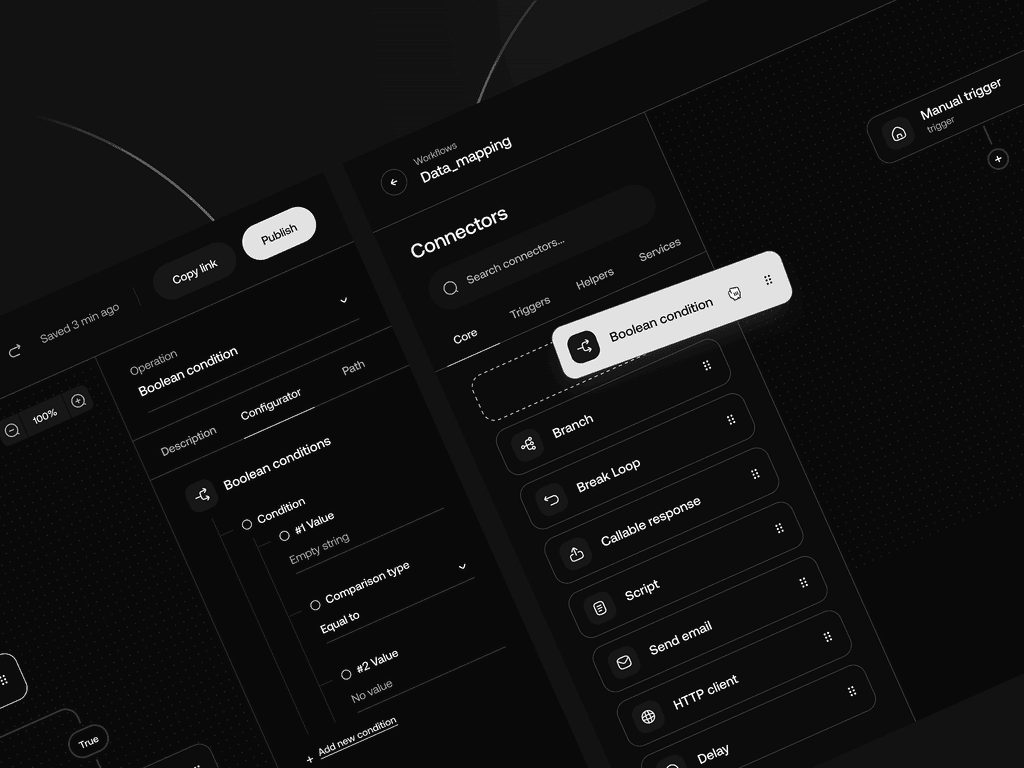
Blog
June 12, 2024
Harnessing the Power of Big Data for Smarter Decision Making

Blog
June 12, 2024
Harnessing the Power of Big Data for Smarter Decision Making
Explore how harnessing the power of Big Data can transform decision-making in your business, from enhancing customer insights to optimizing operations and leveraging predictive analytics. Learn the steps to effectively implement Big Data strategies and stay competitive in today’s data-driven world.
In the digital age, data is more than just a byproduct of business operations—it’s a vital asset that, when harnessed correctly, can drive smarter decision-making and strategic success. Big Data refers to the vast volumes of structured and unstructured data that businesses generate every day. By effectively leveraging this data, organizations can gain valuable insights, enhance operational efficiency, and make informed decisions that propel growth. Here’s an in-depth look at how Big Data can transform decision-making processes and why it’s crucial for modern businesses.
The Significance of Big Data
Big Data encompasses a wide array of information, from customer transactions and social media interactions to sensor data and machine logs. According to a report by IDC, the global datasphere will grow to 175 zettabytes by 2025, up from 33 zettabytes in 2018【IDC】. This exponential growth underscores the increasing importance of data in the business landscape.
Harnessing Big Data involves collecting, processing, and analyzing these large datasets to uncover patterns, trends, and associations. These insights can provide a competitive edge, allowing businesses to anticipate market trends, optimize operations, and deliver personalized customer experiences.
Transforming Decision Making with Big Data
1. Enhanced Customer Insights
Big Data enables businesses to understand their customers better by analyzing behavioral patterns and preferences. For example, Amazon uses Big Data to recommend products based on past purchases and browsing history, significantly enhancing customer satisfaction and boosting sales. According to McKinsey, companies that leverage customer behavior insights outperform peers by 85% in sales growth and more than 25% in gross margin【McKinsey】.
2. Operational Efficiency
Big Data analytics can streamline operations by identifying inefficiencies and optimizing resource allocation. For instance, logistics companies use Big Data to optimize delivery routes, reducing fuel consumption and improving delivery times. A study by Capgemini found that 78% of organizations using Big Data saw improvements in operational processes【Capgemini】.
3. Predictive Analytics
Predictive analytics, powered by Big Data, allows businesses to forecast future trends and behaviors. This capability is particularly valuable in risk management, inventory forecasting, and market analysis. For example, financial institutions use predictive models to assess credit risk and detect fraudulent activities. Gartner predicts that by 2022, predictive and prescriptive analytics will attract 40% of enterprises’ net new investment in business intelligence and analytics【Gartner】.
4. Real-Time Decision Making
With the advent of advanced analytics tools, businesses can analyze data in real-time, enabling swift decision-making. Retailers can adjust pricing strategies based on real-time sales data, while manufacturers can monitor production lines to detect and resolve issues immediately. This agility can be a significant differentiator in highly competitive markets.
Implementing Big Data Strategies
To effectively harness the power of Big Data, businesses should follow these steps:
1. Data Collection and Integration
Gather data from various sources, including transactional systems, social media, and IoT devices. Ensure that data is integrated into a centralized platform for seamless analysis. Tools like Apache Hadoop and Amazon Redshift can facilitate data storage and processing.
2. Data Quality Management
Maintain high data quality by implementing data cleansing and validation processes. Accurate and reliable data is essential for generating meaningful insights. According to IBM, poor data quality costs the US economy around $3.1 trillion annually【IBM】.
3. Advanced Analytics
Utilize advanced analytics techniques such as machine learning, artificial intelligence, and natural language processing to analyze Big Data. Platforms like Apache Spark and TensorFlow can help in building sophisticated analytical models.
4. Data Governance
Establish robust data governance frameworks to ensure data privacy, security, and compliance with regulations such as GDPR and CCPA. Effective governance also promotes data transparency and accountability.
5. Skilled Workforce
Invest in training and hiring skilled data scientists, analysts, and engineers who can drive Big Data initiatives. According to LinkedIn, data science is one of the fastest-growing job sectors, with a 37% annual growth rate【LinkedIn】.
Conclusion
Harnessing the power of Big Data is essential for smarter decision-making in today’s data-driven world. By leveraging advanced analytics, businesses can gain deeper insights, enhance operational efficiency, and make informed decisions that drive growth and innovation. The journey to effective Big Data utilization involves collecting high-quality data, applying sophisticated analytical techniques, and fostering a culture of data-driven decision-making. As the volume of data continues to grow, businesses that prioritize Big Data strategies will be well-positioned to thrive in the competitive landscape.
For more information on leveraging Big Data for smarter decision-making, visit the following resources:
• IDC Global Datasphere Forecast
• McKinsey & Company: Customer Insights
• Gartner Predictive Analytics Forecast
• LinkedIn Emerging Jobs Report
By implementing these strategies, businesses can unlock the full potential of Big Data, driving smarter decision-making and achieving sustainable success.
In the digital age, data is more than just a byproduct of business operations—it’s a vital asset that, when harnessed correctly, can drive smarter decision-making and strategic success. Big Data refers to the vast volumes of structured and unstructured data that businesses generate every day. By effectively leveraging this data, organizations can gain valuable insights, enhance operational efficiency, and make informed decisions that propel growth. Here’s an in-depth look at how Big Data can transform decision-making processes and why it’s crucial for modern businesses.
The Significance of Big Data
Big Data encompasses a wide array of information, from customer transactions and social media interactions to sensor data and machine logs. According to a report by IDC, the global datasphere will grow to 175 zettabytes by 2025, up from 33 zettabytes in 2018【IDC】. This exponential growth underscores the increasing importance of data in the business landscape.
Harnessing Big Data involves collecting, processing, and analyzing these large datasets to uncover patterns, trends, and associations. These insights can provide a competitive edge, allowing businesses to anticipate market trends, optimize operations, and deliver personalized customer experiences.
Transforming Decision Making with Big Data
1. Enhanced Customer Insights
Big Data enables businesses to understand their customers better by analyzing behavioral patterns and preferences. For example, Amazon uses Big Data to recommend products based on past purchases and browsing history, significantly enhancing customer satisfaction and boosting sales. According to McKinsey, companies that leverage customer behavior insights outperform peers by 85% in sales growth and more than 25% in gross margin【McKinsey】.
2. Operational Efficiency
Big Data analytics can streamline operations by identifying inefficiencies and optimizing resource allocation. For instance, logistics companies use Big Data to optimize delivery routes, reducing fuel consumption and improving delivery times. A study by Capgemini found that 78% of organizations using Big Data saw improvements in operational processes【Capgemini】.
3. Predictive Analytics
Predictive analytics, powered by Big Data, allows businesses to forecast future trends and behaviors. This capability is particularly valuable in risk management, inventory forecasting, and market analysis. For example, financial institutions use predictive models to assess credit risk and detect fraudulent activities. Gartner predicts that by 2022, predictive and prescriptive analytics will attract 40% of enterprises’ net new investment in business intelligence and analytics【Gartner】.
4. Real-Time Decision Making
With the advent of advanced analytics tools, businesses can analyze data in real-time, enabling swift decision-making. Retailers can adjust pricing strategies based on real-time sales data, while manufacturers can monitor production lines to detect and resolve issues immediately. This agility can be a significant differentiator in highly competitive markets.
Implementing Big Data Strategies
To effectively harness the power of Big Data, businesses should follow these steps:
1. Data Collection and Integration
Gather data from various sources, including transactional systems, social media, and IoT devices. Ensure that data is integrated into a centralized platform for seamless analysis. Tools like Apache Hadoop and Amazon Redshift can facilitate data storage and processing.
2. Data Quality Management
Maintain high data quality by implementing data cleansing and validation processes. Accurate and reliable data is essential for generating meaningful insights. According to IBM, poor data quality costs the US economy around $3.1 trillion annually【IBM】.
3. Advanced Analytics
Utilize advanced analytics techniques such as machine learning, artificial intelligence, and natural language processing to analyze Big Data. Platforms like Apache Spark and TensorFlow can help in building sophisticated analytical models.
4. Data Governance
Establish robust data governance frameworks to ensure data privacy, security, and compliance with regulations such as GDPR and CCPA. Effective governance also promotes data transparency and accountability.
5. Skilled Workforce
Invest in training and hiring skilled data scientists, analysts, and engineers who can drive Big Data initiatives. According to LinkedIn, data science is one of the fastest-growing job sectors, with a 37% annual growth rate【LinkedIn】.
Conclusion
Harnessing the power of Big Data is essential for smarter decision-making in today’s data-driven world. By leveraging advanced analytics, businesses can gain deeper insights, enhance operational efficiency, and make informed decisions that drive growth and innovation. The journey to effective Big Data utilization involves collecting high-quality data, applying sophisticated analytical techniques, and fostering a culture of data-driven decision-making. As the volume of data continues to grow, businesses that prioritize Big Data strategies will be well-positioned to thrive in the competitive landscape.
For more information on leveraging Big Data for smarter decision-making, visit the following resources:
• IDC Global Datasphere Forecast
• McKinsey & Company: Customer Insights
• Gartner Predictive Analytics Forecast
• LinkedIn Emerging Jobs Report
By implementing these strategies, businesses can unlock the full potential of Big Data, driving smarter decision-making and achieving sustainable success.
Explore how harnessing the power of Big Data can transform decision-making in your business, from enhancing customer insights to optimizing operations and leveraging predictive analytics. Learn the steps to effectively implement Big Data strategies and stay competitive in today’s data-driven world.
In the digital age, data is more than just a byproduct of business operations—it’s a vital asset that, when harnessed correctly, can drive smarter decision-making and strategic success. Big Data refers to the vast volumes of structured and unstructured data that businesses generate every day. By effectively leveraging this data, organizations can gain valuable insights, enhance operational efficiency, and make informed decisions that propel growth. Here’s an in-depth look at how Big Data can transform decision-making processes and why it’s crucial for modern businesses.
The Significance of Big Data
Big Data encompasses a wide array of information, from customer transactions and social media interactions to sensor data and machine logs. According to a report by IDC, the global datasphere will grow to 175 zettabytes by 2025, up from 33 zettabytes in 2018【IDC】. This exponential growth underscores the increasing importance of data in the business landscape.
Harnessing Big Data involves collecting, processing, and analyzing these large datasets to uncover patterns, trends, and associations. These insights can provide a competitive edge, allowing businesses to anticipate market trends, optimize operations, and deliver personalized customer experiences.
Transforming Decision Making with Big Data
1. Enhanced Customer Insights
Big Data enables businesses to understand their customers better by analyzing behavioral patterns and preferences. For example, Amazon uses Big Data to recommend products based on past purchases and browsing history, significantly enhancing customer satisfaction and boosting sales. According to McKinsey, companies that leverage customer behavior insights outperform peers by 85% in sales growth and more than 25% in gross margin【McKinsey】.
2. Operational Efficiency
Big Data analytics can streamline operations by identifying inefficiencies and optimizing resource allocation. For instance, logistics companies use Big Data to optimize delivery routes, reducing fuel consumption and improving delivery times. A study by Capgemini found that 78% of organizations using Big Data saw improvements in operational processes【Capgemini】.
3. Predictive Analytics
Predictive analytics, powered by Big Data, allows businesses to forecast future trends and behaviors. This capability is particularly valuable in risk management, inventory forecasting, and market analysis. For example, financial institutions use predictive models to assess credit risk and detect fraudulent activities. Gartner predicts that by 2022, predictive and prescriptive analytics will attract 40% of enterprises’ net new investment in business intelligence and analytics【Gartner】.
4. Real-Time Decision Making
With the advent of advanced analytics tools, businesses can analyze data in real-time, enabling swift decision-making. Retailers can adjust pricing strategies based on real-time sales data, while manufacturers can monitor production lines to detect and resolve issues immediately. This agility can be a significant differentiator in highly competitive markets.
Implementing Big Data Strategies
To effectively harness the power of Big Data, businesses should follow these steps:
1. Data Collection and Integration
Gather data from various sources, including transactional systems, social media, and IoT devices. Ensure that data is integrated into a centralized platform for seamless analysis. Tools like Apache Hadoop and Amazon Redshift can facilitate data storage and processing.
2. Data Quality Management
Maintain high data quality by implementing data cleansing and validation processes. Accurate and reliable data is essential for generating meaningful insights. According to IBM, poor data quality costs the US economy around $3.1 trillion annually【IBM】.
3. Advanced Analytics
Utilize advanced analytics techniques such as machine learning, artificial intelligence, and natural language processing to analyze Big Data. Platforms like Apache Spark and TensorFlow can help in building sophisticated analytical models.
4. Data Governance
Establish robust data governance frameworks to ensure data privacy, security, and compliance with regulations such as GDPR and CCPA. Effective governance also promotes data transparency and accountability.
5. Skilled Workforce
Invest in training and hiring skilled data scientists, analysts, and engineers who can drive Big Data initiatives. According to LinkedIn, data science is one of the fastest-growing job sectors, with a 37% annual growth rate【LinkedIn】.
Conclusion
Harnessing the power of Big Data is essential for smarter decision-making in today’s data-driven world. By leveraging advanced analytics, businesses can gain deeper insights, enhance operational efficiency, and make informed decisions that drive growth and innovation. The journey to effective Big Data utilization involves collecting high-quality data, applying sophisticated analytical techniques, and fostering a culture of data-driven decision-making. As the volume of data continues to grow, businesses that prioritize Big Data strategies will be well-positioned to thrive in the competitive landscape.
For more information on leveraging Big Data for smarter decision-making, visit the following resources:
• IDC Global Datasphere Forecast
• McKinsey & Company: Customer Insights
• Gartner Predictive Analytics Forecast
• LinkedIn Emerging Jobs Report
By implementing these strategies, businesses can unlock the full potential of Big Data, driving smarter decision-making and achieving sustainable success.
Other Blogs
Other Blogs
Check our other project Blogs with useful insight and information for your businesses
Other Blogs
Other Blogs
Check our other project Blogs with useful insight and information for your businesses
Other Blogs
Other Blogs
Check our other project Blogs with useful insight and information for your businesses


